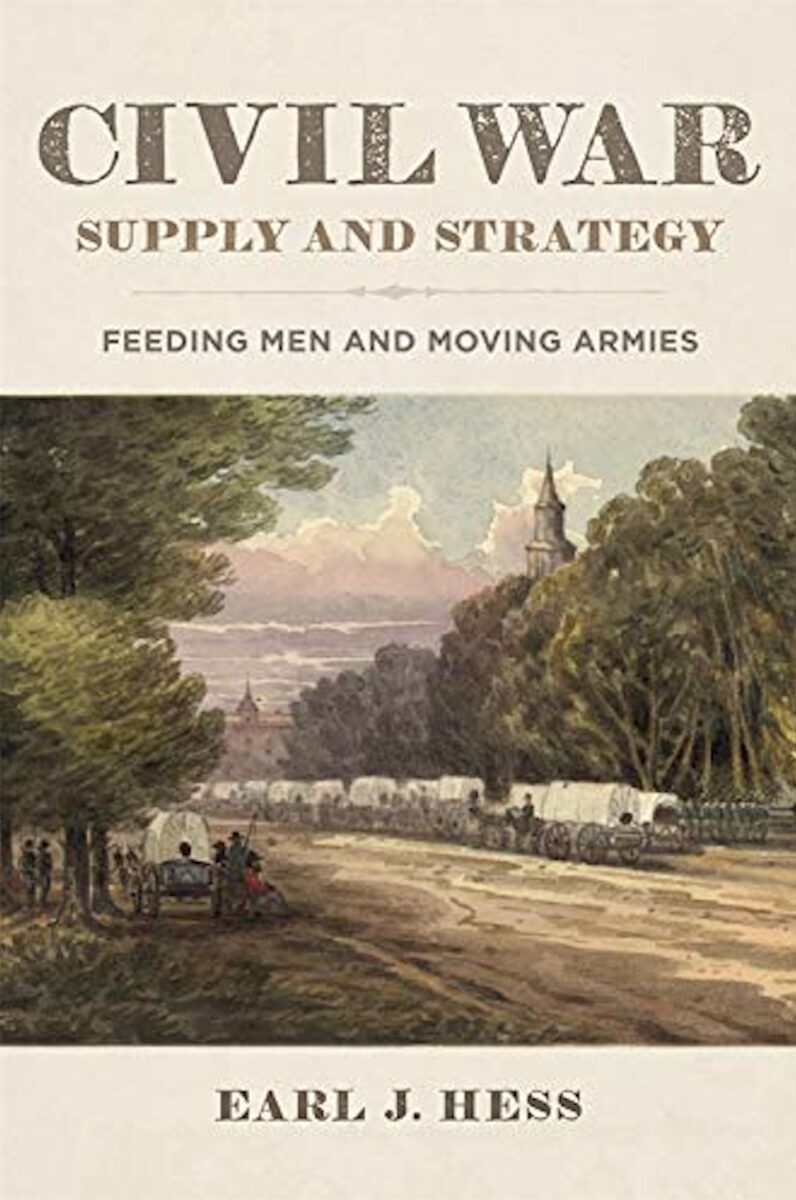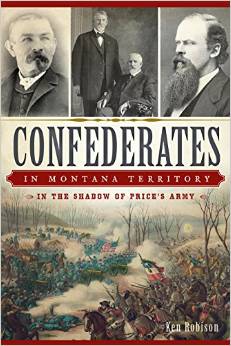Earl J. Hess is an exceptionally productive historian of the U.S. Civil War. Recently retired from Lincoln Memorial University, where he held the Stewart McClelland Chair in History, Hess has published over two dozen volumes to date. Some of his books ask scholars to reassess long-held perspectives (The Most Hated Man of the Confederacy). Others offer eminently readable narratives of battles and campaigns (The Civil War in the West). Still more illuminate long-overlooked subjects like supply and logistics (Civil War Supply and Strategy, which complements Civil War Logistics: A Study of Military Transportation). Civil War Supply and Strategy examines “how generals and their subordinates organized military resources to move both men and animals under their command and to feed and supply them with all manner of material along the way” (1). Although he analyzes all three theaters of the war—Eastern, Western, and Trans-Mississippi—Hess focuses on the Western Theater, “because that is where the problems of shipping material and moving large armies were most formidable” (2). He emphasizes U.S. logistics, but also discusses Pemberton’s efforts to stockpile food at Vicksburg, Hood in North Georgia and Tennessee, and feeding the Army of Northern Virginia.
Logistics and supply might not seem a particularly exciting subject, but Hess successfully demonstrates how vital they were to an army’s success or failure. He also illustrates the sheer magnitude of the task of feeding an army. Case in point: during the 120-day Atlanta Campaign, General William T. Sherman needed 22,500 tons of food for his 100,000 effectives and 25,200 tons of grain and 16,800 tons of hay for his horses and mules. This came to 64,500 tons of food. It would have required a forty-mile line of boxcars to transport these provisions to the army. Railroad management is an important theme in this book because “learning how to manage railroads became a major focus of the war for Federal authorities, and it is impossible to tell the story of logistics and supply in the theater of operations without discussing that process” (3). Western railroad management lagged behind Eastern railroad management for several years because Western generals often relied on military officers, rather than civilians with railroad experience. It took an infusion of highly-skilled Eastern civilians to bring Western railroads up to scratch. This was particularly important, because the Civil War was the first true railroad war in history.
United States victory was “built on immense logistical power; it was the only way that Federal armies could penetrate Confederate territory and exert control over selected regions of the South. Strategy was therefore heavily dependent on lines of supply, road systems, preexisting railroad lines, and natural watercourses” (8). That said, strategic objectives sometimes conflicted with the problems of supply. For example, at the beginning of the U.S. Civil War, many people emphasized the importance of a military campaign to aid East Tennessee loyalists. However, one of the strongest arguments against such a campaign became the difficulty of the terrain the army would have to master. Commanders deferred the invasion of East Tennessee for several years. Hess makes a good point about the accessibility of much of the Upper South versus the inaccessibility of the Lower South, but he also notes that the East Tennessee example demonstrates how Upper South campaigns could be fraught with difficulty, especially in the “heart of Appalachia, with its steep grades and bridges over treacherous mountain streams” (43).
The story of the Vicksburg Campaign has been told many times, although some people might forget, given General Ulysses S. Grant’s eventual reliance on the Mississippi River, that when he planned “a major push against Vicksburg in the fall of 1862, rather than to the river, he looked primarily to the rail system as his support” (56). After Earl Van Dorn destroyed Holly Springs, most observers concluded that “the Mississippi River was a more secure line of operations than the Mississippi Central Railroad” (67). In his account of the Vicksburg Campaign, Hess offers considerable praise for Grant, noting that he “demonstrated his skill as a masterful logistician” (82) and “the marvel of Grant’s Vicksburg Campaign is that he ended the overland march exactly where he needed to be in order to reconnect with the river steamers north of Vicksburg” (82). The contrast in logistics and supply between the U.S. forces and the rebels could not have been sharper. “Even today,” Hess notes, “it is a wonder that Pemberton failed to stockpile enough food in Vicksburg to withstand a lengthy siege” (84). This should have been one of Pemberton’s easier tasks, but “the inefficiency of the Confederate system of finding, purchasing, and transporting commissary supplies” hurt Pemberton. That said, Pemberton also deserves considerable blame because he “alienated the most efficient commissary agent available to him, William A. Broadwell, and severely hampered his ability to purchase food” (88). In what became a theme for the rebels, railroad officials refused to prioritize supplies the army needed. The failure to create a stockpile at Vicksburg is even more striking because the rebels possessed so many advantages and the U.S. forces so many disadvantages. Ironically, Grant had an easier time feeding 30,000 men “perched at the tail end of a long tether of steamboats linking him with cities more than 200 miles away than Pemberton could feed his 20,000 men located only a few miles from rich corn-producing regions of his own territory” (98).
U.S. forces showed considerable skill in overcoming supply challenges in the capture of Vicksburg. That said, a different geographic region—the Appalachian Highlands—posed a major threat to U.S. logistics. General William Starke Rosecrans and other western generals tended to militarize the logistics system by relying on military officers rather than civilians. Rosecrans’s logistical and supply situation deteriorated as he moved across the mountains in August 1863. After the loss at Chickamauga, he withdrew to Chattanooga; there, the supply situation became desperate. Lincoln sent Grant to Chattanooga and, critically, “inadequate supplies did not prevent Grant from winning a decisive victory that reserved the strategic situation around Chattanooga in one stroke” (125). Despite the victory, U.S. soldiers remained underfed and undersupplied. Although both the U.S. and the rebels suffered from supply deficiencies, the U.S. invested more resources to solve them. Daniel McCallum traveled west with members of the Construction Corps, evaluated the rail system, and began months of ceaseless labor to improve the system. This proved to be a “watershed in the history of logistical support in the western campaigns” (137).
One of the most important results of the transfer of Eastern railroad men to the West was that they created the system that made the Atlanta Campaign possible. This campaign was “the only attempt by the Federals to penetrate the Deep South while relying on a railroad to support large forces” (139). Although everyone involved in Sherman’s supply exerted themselves in extraordinary ways, “they were barely able to accomplish the task of supporting the army group’s capture of the city after four months of continuous campaigning” (139). The amount of food required by Sherman’s men, horses, and mules provides an idea of the difficulty of supply. Indeed, “the logistical history of the Atlanta Campaign was unprecedented not only in the Civil War but also in world military history” (139). Although the Army of Tennessee faced some supply challenges, largely due to the weakness of the rebel supply system, the U.S. forces faced and overcame far greater challenges (as they did during the Vicksburg Campaign).
After Sherman captured Atlanta, Hood seized the strategic initiative. Logistics and supply played an important role in Hood’s invasion of Tennessee and in General George H. Thomas’s pursuit of Hood’s defeated army after the Battle of Nashville. Although Thomas mounted “one of the largest pursuits of a beaten army during the Civil War” (215), the pursuit “witnessed some of the most difficult improvised crossings of streams to be found during the Civil War” (217). Hood’s army ultimately saved itself by “a few adroit measures and fast marching” (234) and “the Union pursuit of the Army of Tennessee was foiled by logistical and supply problems that greatly impaired mobility” (234).
As Hood prepared for his invasion of Tennessee, Sherman prepared for his March to the Sea. Sherman decided to live off the land rather than using the railroad as a supply line as he did during the Atlanta Campaign. Hess offers a good overview of the March to the Sea and Sherman’s subsequent march through the Carolinas. Sherman utilized coastal shipping during the Carolina Campaign, and Montgomery Meigs reported that “ninety-eight vessels supplied Sherman’s army group with 37,539 tons of material” (253). Hess asks readers to consider how the final stages of the war might have changed if “those ninety-eight vessels had been used to transport Sherman’s men from Savannah to Petersburg rather than relying on the slow process of marching” (253).
The final three chapters examine the Trans-Mississippi Theater, the Army of the Potomac, and the Army of Northern Virginia. Large-scale military operations, Hess contends, were “even more problematic west of the Mississippi than east of it. With fewer railroads, fewer farms, and seemingly trackless expanses, it represented an operational environment somewhere between the wilderness of the frontier and the largely settled regions of the Eastern Seaboard” (266). Federal armies generally relied on wagon trains and feeding from the countryside, but it often became difficult to supply garrisons. Inadequate means of transportation doomed General Nathaniel P. Banks’s Red River Campaign, one of the largest in this theater. In general, all soldiers suffered from hunger in the Trans-Mississippi – rebels more than the U.S. soldiers.
In contrast to supply and logistics in the Tans-Mississippi Theater, the Army of the Potomac faced a very different situation. Geography “offered it some degree of latitude in choosing modes of supply as it advanced 100 miles south from Washington to Richmond” (291). The quality of railroad personnel, best exemplified by Herman Haupt and Daniel McCallum, was considerably better in the East than in the West (at least until several Easterners went West). The Army of the Potomac’s strategic mission did not involve invading the Deep South; they stayed in the Upper South and occasionally chased Lee out of the Lower North. Finally, the Army of the Potomac, unlike other Civil War armies, faced a problem of abundance, not scarcity. Victory in the East, Hess contends, rode on the work of quartermasters and commissaries.
The Army of Northern Virginia, on the other hand, faced a poor strategic situation because the army had to defend the rebel capital. Supplying this army proved daunting. Far more problematic than limited resources was the “pervasive ineffectiveness that characterized every aspect of Confederate administrative life, especially its logistical and supply arrangements” (329). Lee, like Pemberton, often became his own worst enemy and his “reluctance to cooperate with Northrop’s agents is not easy to understand” (335). Railroad preferred to serve civilians, rather than the rebel government, because civilians were better customers. Railroads served the army poorly, but Hess also notes how extraordinary it was that rebel commissaries in Vicksburg and Virginia had such difficulty stockpiling provisions and feeding soldiers in friendly territory. “In no other area of the war,” he argues, “could one see such a dichotomy between the operating style and effectiveness of Northern and Southern institutions as in the area of logistics and supply—the difference is stunning” (361).
Civil War logistics and supply, Hess sensibly concludes, “were among the most important factors in determining the outcome of the conflict” (363). It is very hard to argue with this conclusion, especially after reading this deeply-researched, well-written, and insightful volume. Hess has produced another study that anyone interested in the U.S. Civil War Era would do well to consult.
Evan C. Rothera is an Assistant Professor of History at the University of Arkansas—Fort Smith.





